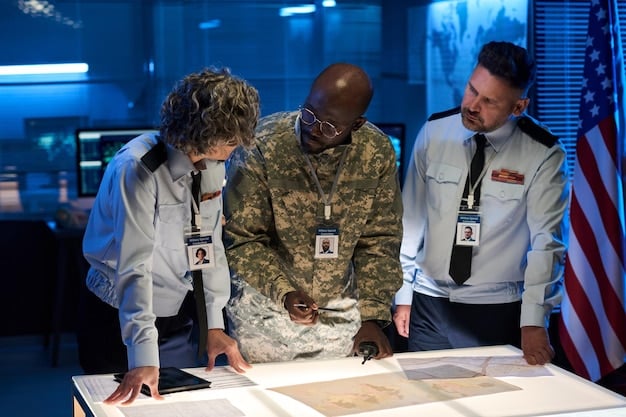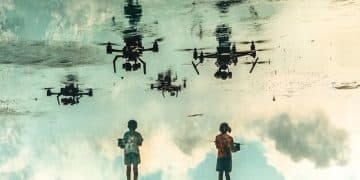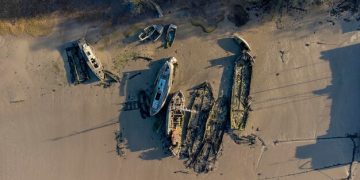US Military Pilot Shortage Crisis: Solutions & Impact

The US military is actively combating its persistent pilot shortage through a multifaceted strategy involving enhanced retention incentives, increased recruitment efforts, and modernization of training pipelines to ensure operational readiness and future air superiority.
The question of How is the US Military Addressing the Pilot Shortage Crisis is gaining significant traction within military circles and among the public. This complex issue, impacting readiness and mission effectiveness, requires a diligent, multi-pronged strategy to ensure the nation’s air power remains unchallenged. From retention bonuses to innovative training, the Department of Defense is exploring every avenue to keep cockpits filled and skilled aviators in uniform.
Understanding the Scope of the Pilot Shortage
The pilot shortage within the US military is a challenge that has evolved significantly over the past decade. It’s not a new phenomenon, but its persistent nature and increasing severity have raised alarms across all branches. This shortage isn’t merely about numbers; it delves into the critical need for experienced, combat-ready aviators who can lead complex missions and train the next generation.
Several factors contribute to this persistent deficit. One of the most prominent is the intense competition from the commercial airline sector. As the global aviation industry expands, airlines offer lucrative salaries, attractive benefits, and predictable schedules that often surpass what the military can provide for career pilots. This “pull factor” creates a significant drain on military talent, especially among mid-career officers with valuable flight hours and leadership experience.
Commercial Competition and Retention Challenges
The allure of civilian life, coupled with faster career progression and reduced deployment cycles, makes airline careers particularly appealing. This competition isn’t confined to a specific branch; it affects the Air Force, Navy, and Marine Corps alike, all of whom face the challenge of retaining their most experienced fliers. The monetary incentives are often the most cited reason for departure, but quality of life, family considerations, and autonomy also play crucial roles.
- Increased demand for pilots in commercial airlines.
- Higher salaries and better work-life balance in the private sector.
- Faster career progression opportunities outside the military.
Another layer to the problem is the demanding nature of military pilot careers. Extended deployments, rigorous training schedules, and high operational tempos can lead to burnout and stress. The separation from families for prolonged periods also contributes to the decision to leave military service for a more stable civilian career. This human element, though less tangible than salary figures, is equally significant in understanding why pilots choose to transition out of uniform.
Furthermore, the high cost and time investment in training a military pilot mean that every departure represents a substantial loss of taxpayer money and a void in operational capability. The pipeline for producing a fully qualified fighter pilot, for instance, can take years and cost millions of dollars. When these individuals leave prematurely, the return on investment diminishes, and the burden on remaining pilots increases.
In essence, the pilot shortage is a multifaceted issue driven by economic incentives, quality of life considerations, and the inherent challenges of military service. Addressing it requires a comprehensive approach that tackles both the “push” factors driving pilots out and the “pull” factors drawing them into the commercial sector.
Enhanced Recruitment and Training Initiatives
To combat the dwindling numbers in their cockpits, the US military has launched a series of aggressive recruitment and training initiatives designed to attract new talent and streamline the pipeline for aspiring aviators. These efforts aim to not only fill current vacancies but also to ensure a steady supply of qualified pilots for future needs.
One primary focus has been on expanding training capacities. All branches are investing in more flight instructors, modernizing aircraft fleets used for training, and upgrading simulation technology. This helps increase throughput, allowing more candidates to enter and complete pilot training programs in a shorter, yet still effective, timeframe. The goal is to maximize the efficiency of the training infrastructure without compromising on the quality and competency of the pilots produced.

Innovative Training Approaches
Beyond simply increasing capacity, the military is also exploring and implementing innovative training approaches. This includes leveraging virtual reality (VR) and augmented reality (AR) technologies for realistic flight simulations, allowing pilots to gain valuable experience in a controlled environment before stepping into an actual cockpit. These technologies can reduce reliance on actual flight hours for certain aspects of training, potentially cutting costs and accelerating the learning process.
- Increased use of virtual and augmented reality in pilot training.
- Emphasis on modernizing training aircraft and facilities.
- Streamlining the instructor pipeline to meet demand.
Recruitment strategies are also undergoing significant changes. The military is broadening its outreach to a more diverse pool of candidates, including those from underrepresented communities and individuals without a traditional aviation background. They are also working to educate the public, especially young people, about the unique opportunities and benefits of a military aviation career, often highlighting the advanced technology, global reach, and professional development inherent in the roles.
Furthermore, accessibility to early flight experience is being considered. Programs that expose potential recruits to aviation at a younger age could foster interest and provide a foundation for future military careers. This includes partnerships with civilian flight schools and university ROTC programs to identify and nurture talent early on. The objective is to make military aviation a more appealing and viable career path from the outset.
These recruitment and training initiatives represent a proactive stance by the US military, demonstrating a clear commitment to addressing the pilot shortage by fostering a robust and efficient pipeline from initial interest to fully qualified aviator. The success of these programs will be crucial in restoring and maintaining the desired pilot readiness levels across all branches.
Financial Incentives and Retention Programs
One of the most direct and impactful strategies the US military is employing to combat the pilot shortage is the implementation of robust financial incentives and comprehensive retention programs. Recognizing the substantial financial appeal of commercial airlines, the military aims to make a career in uniform competitive and rewarding enough to retain its highly skilled aviators.
A cornerstone of these efforts is the offering of significant retention bonuses. These bonuses are typically offered to experienced pilots who agree to commit to additional years of service beyond their initial obligation. The amounts vary based on aircraft type, experience level, and the specific needs of each branch, but they are often substantial, sometimes reaching six figures over the course of a new service commitment. The goal is to provide a strong financial reason for pilots to forgo the immediate allure of airline salaries.
Tailored Retention Bonuses
These bonuses are often tiered, meaning that pilots who sign up for longer commitments receive larger sums, encouraging a more enduring dedication to military service. The Air Force, Navy, and Marine Corps each have their own bonus structures, continually adjusting them based on real-time attrition rates and projections. This dynamic approach allows the military to respond flexibly to market demands and internal needs, targeting specific pilot communities that are most at risk of departure.
- Significant retention bonuses for experienced military pilots.
- Tiered bonus structures for longer service commitments.
- Branch-specific incentives tailored to unique aviation needs.
Beyond direct monetary incentives, the military is also enhancing non-financial benefits that contribute to overall quality of life and career satisfaction. These include improvements in housing, childcare, and healthcare services for military families. Recognizing that families play a crucial role in a pilot’s decision to stay or leave, these initiatives aim to alleviate some of the pressures associated with military life. Efforts are also being made to stabilize assignments and reduce frequent permanent change of station (PCS) moves, which can be highly disruptive for families.
Career progression and professional development opportunities are also being highlighted and enhanced. Pilots are being offered clearer paths to leadership roles, advanced training, and opportunities to fly diverse aircraft types. The unique experiences gained in military aviation, such as combat operations and diplomatic engagements, are emphasized as invaluable professional assets that civilian careers often cannot replicate.
In short, the military’s approach to financial incentives and retention programs is multifaceted, blending substantial monetary rewards with improvements in quality of life and compelling career development opportunities. These strategies are vital in countering the commercial sector’s pull and ensuring that the nation retains its most valuable winged assets.
Addressing Quality of Life and Work-Life Balance
Beyond mere financial incentives, the US military is increasingly recognizing that addressing the quality of life and work-life balance for its pilots is paramount to stemming the tide of departures. The demanding nature of military aviation, with its long hours, frequent deployments, and periods of high stress, can significantly impact a pilot’s personal life and overall well-being. Efforts are now underway to mitigate these challenges and create a more sustainable environment for aviators and their families.
One key area of focus is reducing the operational tempo where feasible. While the demands of national security dictate a certain level of activity, military leaders are exploring ways to optimize training schedules and deployment cycles to minimize unnecessary time away from home. This might involve more efficient use of simulation technologies to reduce actual flight hours during non-critical phases of training, or strategic personnel management to ensure no single pilot or squadron is perpetually overextended.
Support for Military Families
Support for military families is another critical component. Recognizing that a pilot’s job satisfaction is often intertwined with the well-being of their family, the military is investing in expanded and improved family support services. This includes better access to quality childcare, enhanced educational resources for children, and more robust spousal employment assistance programs. These measures aim to alleviate some of the unique burdens placed on military families, making the lifestyle more manageable and appealing.
- Optimizing operational tempo and deployment schedules.
- Enhanced family support services, including childcare and education.
- Improved mental health support and counseling for pilots.
Mental health and well-being initiatives are also gaining prominence. The strains of military flying, especially in combat zones, can take a significant toll. The military is working to destigmatize seeking mental health assistance and is increasing access to counseling services, resilience training, and peer support programs. Ensuring pilots have the resources to cope with stress and maintain psychological health is crucial for long-term retention and overall readiness.
Furthermore, efforts are being made to improve command climates and foster a supportive environment within units. Good leadership, effective communication, and a sense of camaraderie can significantly enhance job satisfaction. Commanders are being trained to be more attuned to their pilots’ well-being and to foster an environment where pilots feel valued, heard, and supported in their professional and personal lives.
By prioritizing quality of life and work-life balance, the US military is shifting towards a more holistic approach to pilot retention. It acknowledges that financial incentives alone are not sufficient and that a sustainable career in military aviation requires a commitment to the overall well-being of its most crucial assets—its pilots and their families.
Technological Advancements and Future Readiness
The US military’s strategy for addressing the pilot shortage crisis isn’t solely focused on personnel; it also heavily incorporates technological advancements to enhance current operations and prepare for future readiness. Innovation in aerospace technology is seen as a key enabler for military superiority, and it plays a dual role in addressing pilot shortfalls: by making existing pilots more effective and by potentially reducing the overall number of pilots needed for certain missions.
A significant aspect of this is the continued development and integration of unmanned aerial systems (UAS), commonly known as drones. These systems can perform a range of missions that previously required a human pilot, from reconnaissance and surveillance to strike operations. As UAS technology advances, their capabilities expand, potentially freeing up manned aircraft pilots for more complex or strategic roles where human presence is indispensable. The development of autonomous and semi-autonomous systems is also progressing, promising to further reduce the workload on human pilots in scenarios like formation flying or aerial refueling.
Leveraging AI and Automation
Artificial intelligence (AI) and automation are also being leveraged to enhance manned aircraft. AI co-pilots or advanced decision-support systems can assist human pilots with tasks like navigation, sensor management, and threat identification, thereby reducing cognitive load and allowing pilots to focus on critical decision-making and tactical execution. This augmentation of human capabilities means that pilots can operate more efficiently and effectively, potentially doing more with less.
- Increased integration of Unmanned Aerial Systems (UAS).
- Development of AI co-pilots and autonomous features.
- Advanced simulation for comprehensive, cost-effective training.
Moreover, technological advancements are revolutionizing pilot training itself. Sophisticated flight simulators, enhanced with virtual reality, augmented reality, and haptics, provide incredibly realistic training environments. These simulators allow pilots to practice complex maneuvers, emergency procedures, and even combat scenarios without consuming costly flight hours or posing safety risks. This technological leap makes training more efficient, cost-effective, and capable of producing highly skilled pilots ready for the demands of modern warfare.
Looking ahead, the military is also exploring concepts like “optionally manned” aircraft, which could be flown by a human pilot or operated remotely, offering ultimate flexibility. While human pilots will always be crucial for certain missions requiring nuanced judgment, adaptability, and high-level strategy, technology is undoubtedly transforming the landscape of military aviation. By embracing these innovations, the US military aims to not only mitigate the pilot shortage but also to redefine the future of air power, ensuring its continued dominance through sophisticated human-machine collaboration.
Inter-Service Collaboration and Long-Term Strategies
Addressing a systemic issue like the pilot shortage requires more than individual service efforts; it demands seamless inter-service collaboration and the development of coherent long-term strategies. The US military, recognizing this imperative, is working to synchronize efforts across the Air Force, Navy, and Marine Corps to ensure a more unified and effective approach to attracting, training, and retaining its aviators.
One key aspect of inter-service collaboration involves sharing best practices and lessons learned. What works for the Air Force in terms of recruitment incentives might be adapted for the Navy, and vice versa. By creating forums for regular communication and joint planning, the services can avoid redundancies, optimize resource allocation, and implement pilot programs that have the highest probability of success. This cooperation extends to joint training exercises and even joint recruitment campaigns that highlight the collective strength and opportunities within military aviation.
Joint Task Forces and Data Sharing
Joint task forces and working groups are often established to analyze pilot retention data, forecast future needs, and recommend policy changes that benefit all aviation communities. This data-driven approach ensures that decisions are based on comprehensive insights across the entire Department of Defense, rather than isolated perspectives from individual branches. Such collaboration fosters a more holistic understanding of the problem and leads to more integrated solutions.
- Sharing best practices and lessons learned across branches.
- Joint task forces to analyze data and recommend policy.
- Integrated recruitment and public awareness campaigns.
From a long-term strategic perspective, the military is focusing on pipeline sustainability. This involves not just fixing the immediate shortage but building a resilient system that can withstand future challenges. This includes long-range planning for training infrastructure development, ensuring enough flight instructors are available for the coming decades, and continually evaluating the market competitiveness of military pilot careers.
The emphasis is also on career path diversification for pilots. Offering varied assignments, opportunities for postgraduate education, and leadership roles outside of traditional flying duties can make military aviation a more attractive and fulfilling career for the long haul. This comprehensive approach aims to create a deeply engaging and rewarding career path, one that encourages aviators to view military service not just as a job, but as a lifelong commitment with continuous opportunities for growth and contribution.
Ultimately, inter-service collaboration and robust long-term strategies are critical for transcending the immediate crisis. By working together and planning for the future, the US military can ensure its air arm remains strong, competitive, and ready for any challenge that lies ahead, securing the nation’s aerial superiority for generations to come.
Challenges and Future Outlook
Despite the comprehensive strategies being implemented, the US military still faces significant challenges in fully resolving the pilot shortage crisis, and the future outlook remains complex. While progress is being made, the underlying forces driving the shortage are powerful and require sustained effort to overcome. Understanding these challenges is crucial for a realistic assessment of the path forward.
One primary challenge is the sheer scale of the commercial aviation boom. As global air travel continues to expand, the demand for experienced pilots in the civilian sector shows no sign of slowing. This means the military will likely face continuous, aggressive competition for talent and will need to perpetually adjust its retention strategies to remain competitive. It’s an ongoing battle for human capital where the scales are often tipped by market forces.
Economic Pressures and Budget Constraints
Economic pressures and budget constraints within the Department of Defense also pose a challenge. While retention bonuses and training investments are crucial, they come with substantial price tags. The ability to fund these initiatives at the necessary levels, particularly in periods of fiscal austerity, could impact their effectiveness and the sustainability of long-term solutions. Balancing these costs with other military priorities is a constant tightrope walk for defense planners.
- Continued strong demand from the commercial aviation sector.
- Budget constraints potentially limiting funding for incentives.
- The long lead time required to train military pilots.
Another inherent challenge is the long lead time required to train a military pilot. It takes years and millions of dollars to transform a recruit into a combat-ready aviator. This means there’s no quick fix; investments made today will only yield fully qualified pilots years down the line. This lag makes it difficult to react rapidly to unexpected surges in pilot departures or unforeseen operational requirements. The pipeline is robust but slow, making predictions and proactive measures vital.
Furthermore, the nature of military service itself will always be a factor. The unique demands of deployments, the risks associated with combat, and the sacrifices inherent in a military career are real considerations for pilots and their families. While the military can enhance quality of life, it cannot entirely remove these elements, meaning that the intrinsic appeal of civilian life for some will always be a powerful draw.
Despite these significant challenges, the future outlook is one of cautious optimism. The military is fully aware of the stakes and is demonstrating remarkable adaptability and ingenuity in its approach. By continually refining its strategies, investing in technology, and prioritizing the well-being of its aviators, the US military is committed to maintaining its air superiority. The pilot shortage is a marathon, not a sprint, and successful mitigation will depend on sustained effort, innovation, and unwavering commitment from all levels of leadership.
| Key Aspect | Brief Description |
|---|---|
| ✈️ Incentives | Significant bonuses and quality-of-life improvements to retain experienced pilots. |
| 🎓 Training | Modernizing facilities, leveraging VR/AR to accelerate and enhance pilot training. |
| 🤖 Technology | Increased use of UAS and AI to augment capabilities and potentially reduce pilot demand. |
| 🤝 Collaboration | Inter-service efforts and long-term strategies for sustainable pilot pipelines. |
Frequently Asked Questions About the Pilot Shortage
The primary reasons for the US military pilot shortage include intense competition from commercial airlines offering higher salaries and better work-life balance, the demanding nature of military service with frequent deployments, and the lengthy, costly training pipeline for military aviators which hinders rapid replacement of departing personnel.
Retention bonuses are a key financial incentive, often six-figure sums, offered to experienced military pilots who agree to extend their service commitments. These bonuses aim to make continued military service more financially attractive compared to immediate commercial airline opportunities, thus retaining invaluable expertise and leadership.
Technology plays a crucial role through the increased use of Unmanned Aerial Systems (UAS) and the development of AI co-pilots, which can reduce reliance on human pilots for certain missions. Advanced flight simulators utilizing VR/AR also make pilot training more efficient, cost-effective, and comprehensive, speeding up the qualification process.
Yes, the military is focusing on improving quality of life by optimizing operational tempo, enhancing family support services like childcare and education, and bolstering mental health resources. These initiatives aim to alleviate stress and provide a more sustainable environment, recognizing that well-being significantly impacts retention.
Long-term strategies involve inter-service collaboration to share best practices, data-driven analysis to forecast needs, and sustained investment in training infrastructure. The goal is to build a resilient and adaptable pilot pipeline that can consistently meet future demands and withstand external competitive pressures, ensuring enduring air superiority.
Conclusion
The US military’s approach to confronting the pilot shortage crisis is a sophisticated tapestry of financial incentives, technological innovation, and a profound commitment to the well-being of its aviators. From substantial retention bonuses to cutting-edge training simulations and a renewed focus on work-life balance, the strategies in place are designed to ensure the nation’s air superiority remains unchallenged. While significant challenges persist, particularly from robust commercial competition, the military’s ongoing adaptability and comprehensive long-term planning are critical in navigating this complex landscape, securing a resilient and capable force of military pilots for generations to come.





